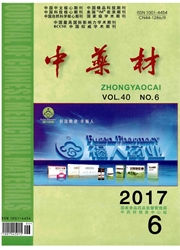

 中文摘要:
中文摘要:
目的:研究人参皂苷Rg。在大鼠体内的药代动力学及其口服生物利用度。方法:人参皂苷Rg。分别静脉(25mg/kg)和灌胃(300mg/kg)给药后,用RP—HPLC法测定大鼠血浆中其血药浓度,数据经3P97药代动力学软件计算药代动力学参数。结果:静脉和灌胃给药后,参数分别为:AUC0→t322.70±20.78、99.76±8.91μg·h/mL,CL0.08±0.02、3.01±0.69L/(kg·h),V0.23±0.01、22.75±2.09L/kg,t1/2α 0.48±0.18、0.87±0.21h,t1/2β 19.57±2.81,18.68±2.74h,MRT16.91±0.99、8.15±1.05h^-1;口服相对生物利用度为2.58%。结论:人参皂苷风.在大鼠体内的相对生物利用度很低。
 英文摘要:
英文摘要:
Objective:To investigate the pharmacokinetics and bioavailability of ginsenoside Rg1 in rats. Methods:Ginsenoside Rg1 was oral administered or intravenous administered to each rat. The plasma concentration of ginsenoside Rg1 was estimated by RP- HPLC. 3P97 software was used to calculate pharmacokinetic parameters. Results: Main parameters of ginsenoside Rg1 after oral or intravenous administered were :AUC→t 322. 70 ± 20. 78, 99. 76 ± 8. 91μg·h/mL, CL 0. 08 ± 0. 02, 3.01 ± 0. 69 L/( kg· h), V 0. 23 ±0.01,22.75 ±2.09 L/kg,t1/2α 0.48 ±0. 18,0.87 ±0.21 h,t1/2β 19.57 ±2.81,18.68 ±2.74 h,MRT6.91 ±0.99,8. 15 ±1.05 h-1, respectively. The relative oral bioavailability of ginsenoside Rg1 was 2. 5%. Conclusion: The oral bioavailability of ginsenoside Rg1 is very low.
 同期刊论文项目
同期刊论文项目
 同项目期刊论文
同项目期刊论文
 期刊信息
期刊信息
